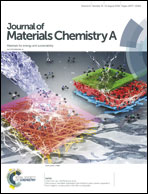Heterolayered 2D nanohybrids of uniformly stacked transition metal dichalcogenide–transition metal oxide monolayers with improved energy-related functionalities†
Abstract
Heterolayered 2D nanohybrids of uniformly stacked transition metal dichalcogenide (TMD)–transition metal oxide (TMO) monolayers are synthesized by a self-assembly of exfoliated nanosheets (NSs) with charge-balancing cations. This is the first example of a layer-by-layer-ordered 2D nanohybrid of exfoliated TMD and TMO nanosheets. The homogeneous incorporation of MnO2 NSs into restacked MoS2 NSs is quite effective in improving the multifunctionality of MoS2 as an electrocatalyst for the hydrogen evolution reaction (HER) and electrode for Li-ion batteries, underscoring the universal merit of layer-by-layer ordering of TMD and TMO NSs. In situ spectroscopic analysis of the present TMD–TMO nanohybrid during the electrocatalytic reaction highlights the efficient interfacial charge transfer of the restacked nanosheets with enhanced porosity. The beneficial effect of incorporated TMO NSs on the performance of TMD NSs is attributable to an efficient interfacial charge transfer and increased porosity with depressed self-stacking of NSs and the stabilization of the metallic 1T TMD phase, resulting in the improvement of charge transfer kinetics, the enhancement of reactivity, and the provision of many reaction sites upon hybridization. Density functional theory (DFT) calculations further support the stabilization of the 1T TMD structure over the 2H TMD one via the interaction with neighboring TMO NSs. The present study clearly demonstrates that the restacking of the colloidal mixtures of TMO and TMD NSs can provide an effective way to explore novel multifunctional heterostructures.



 Please wait while we load your content...
Please wait while we load your content...